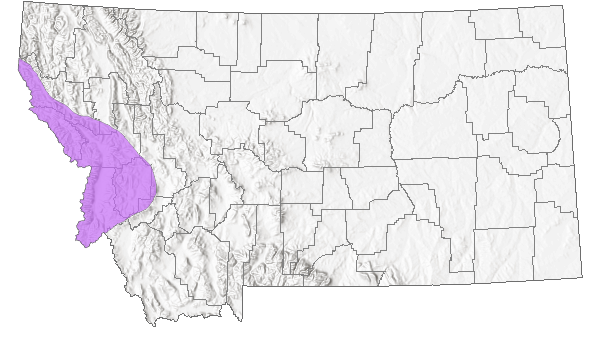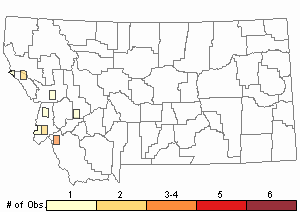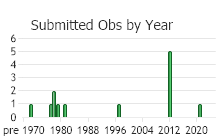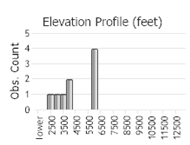View in other NatureServe Network Field Guides
NatureServe
Montana
Utah
Wyoming
Idaho
Wisconsin
British Columbia
South Carolina
Yukon
California
New York
Coville's Rush - Juncus covillei
State Rank Reason (see State Rank above)
Rare and peripheral in Montana. Currently known from approximately a half-dozen widely scattered wetland/riparian sites in the mountainous portion of the state.
General Description
Rhizomatous. Stems erect, compressed, 6–20 cm, sometimes clumped. Leaves basal and cauline; blades flat, 1–2 mm wide; auricles acute or absent. Inflorescence congested with 3 to 7 sessile flowers in each of 1 to 3 clusters; main bract shorter or longer than the inflorescence. Flowers: prophylls absent; tepals brown to purplish with a green midstripe, 3–4 mm long, acute; stamens 6. Capsules 3–5 mm long, truncate on top; seeds without appendages (
Lesica et al. 2012. Manual of Montana Vascular Plants. BRIT Press. Fort Worth, TX).
We have varieties
covillei and
obtusatus C.L. Hitchc.
Phenology
Fruits reach maturity from late August-September
Diagnostic Characteristics
Juncus is a large and difficult genus to distinguish, so a technical key should be consulted. Mature fruit is necessary for positive determination. The combination of flowers subtended by a single bract, flattened leaves, and 7-flowered heads separate J. covillei from most other rhizomatous rushes. The tepals of var obtusatus are pale brown, and the inner ones have pointed tips. In contrast, the tepals of variety covillei are dark brown, and the inner tepals have rounded tips.
Species Range
Montana Range
Range Descriptions

 Native
Native
Range Comments
BC to CA, ID and MT (Lesica et al. 2012. Manual of Montana Vascular Plants. BRIT Press. Fort Worth, TX).
Observations in Montana Natural Heritage Program Database
Number of Observations: 13
(Click on the following maps and charts to see full sized version)
Map Help and Descriptions
Relative Density

Recency



 (Observations spanning multiple months or years are excluded from time charts)
(Observations spanning multiple months or years are excluded from time charts)
Habitat
Variety covillei is typically found in moist, gravelly or sandy soil along major water courses in the valley zone. In contrast, variety obtusatus is found in moist to wet, often seepy soil of slopes and meadows in the montane and subalpine zones.
Ecological Systems Associated with this Species
Stewardship Responsibility
Threats or Limiting Factors
STATE THREAT SCORE REASON
Threat impact not assigned because threats are not known (MTNHP Threat Assessment 2021).
References
- Literature Cited AboveLegend:
 View Online Publication
View Online Publication Lesica, P., M.T. Lavin, and P.F. Stickney. 2012. Manual of Montana Vascular Plants. Fort Worth, TX: BRIT Press. viii + 771 p.
Lesica, P., M.T. Lavin, and P.F. Stickney. 2012. Manual of Montana Vascular Plants. Fort Worth, TX: BRIT Press. viii + 771 p. MTNHP Threat Assessment. 2021. State Threat Score Assignment and Assessment of Reported Threats from 2006 to 2021 for State-listed Vascular Plants. Botany Program, Montana Natural Heritage Program, Helena, Montana.
MTNHP Threat Assessment. 2021. State Threat Score Assignment and Assessment of Reported Threats from 2006 to 2021 for State-listed Vascular Plants. Botany Program, Montana Natural Heritage Program, Helena, Montana.
- Additional ReferencesLegend:
 View Online Publication
View Online Publication
Do you know of a citation we're missing? Lesica, P., M.T. Lavin, and P.F. Stickney. 2022. Manual of Montana Vascular Plants, Second Edition. Fort Worth, TX: BRIT Press. viii + 779 p.
Lesica, P., M.T. Lavin, and P.F. Stickney. 2022. Manual of Montana Vascular Plants, Second Edition. Fort Worth, TX: BRIT Press. viii + 779 p. Vanderhorst, J.P. 1994. Sensitive plant surveys in the Gallatin National Forest, Montana. Unpublished report to the Gallatin National Forest. Montana Natural Heritage Program, Helena, MT. 54 pp.
Vanderhorst, J.P. 1994. Sensitive plant surveys in the Gallatin National Forest, Montana. Unpublished report to the Gallatin National Forest. Montana Natural Heritage Program, Helena, MT. 54 pp. Vanderhorst, J.P. 1994. Survey for sensitive plant species on Doherty Mountain, Jefferson County. Unpublished report to the Butte District, Bureau of Land Management. Montana Natural Heritage Program, Helena, MT. 5 pp. plus appendices.
Vanderhorst, J.P. 1994. Survey for sensitive plant species on Doherty Mountain, Jefferson County. Unpublished report to the Butte District, Bureau of Land Management. Montana Natural Heritage Program, Helena, MT. 5 pp. plus appendices.
- Web Search Engines for Articles on "Coville's Rush"





